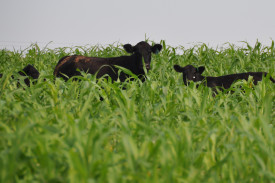Although there is no single accepted defintion of regenerative agriculture, there are many principles and practices that encompass the movement of regenerative agriculture. First and foremost are the principles of soil health: minimize soil disturbance (no-till), keep the soil covered, keep a living root growing for as much time as possible, add diversity of plants to the landscape and integrate grazing livestock onto the land.
Regenerative agriculture takes a more holisitc approach to crop and livestock production than the traditional model of agriculture. Fully-functioning ecosystems that support healthy soil, water, plants, beneficial insects and animals is the goal of regenerative agriculture. Restoring water cycles, improving soil function, increasing diversity of terrestrial and aquatic species, decreasing vulenrabilty to pests and disease, and increasing farm profits are all benefits of a regenerative agriculture system.
Increasing soil organic matter and soil water holding capacity are often mistaken as the goal of regenerative agricultue. These are just two of the goals that embrace a regenerative approach to production. Farming and ranching with ecological principles in mind to keep the biological cycles of soil, water and nutrients continually flowing is the end game for regenerative systems. In short, the system regenerates the resources it uses to build in resilience and reserves. A regenerative agriculture system is diverse, has fully-funciton soil and water systems, and supports heath plant and animal communites.

